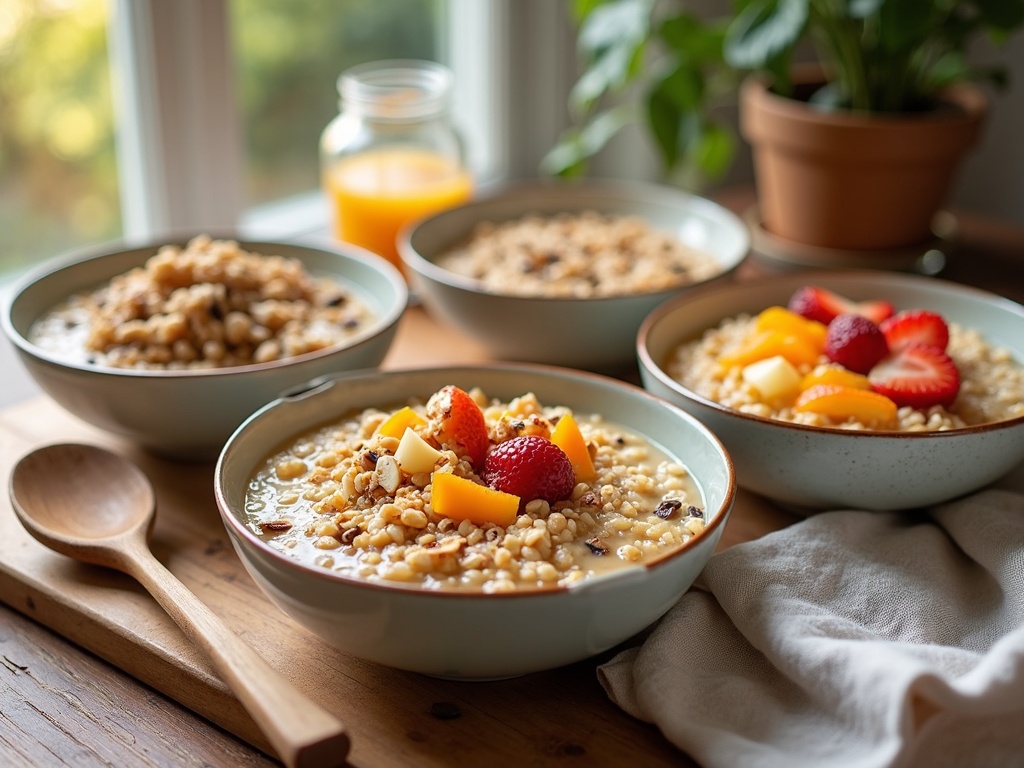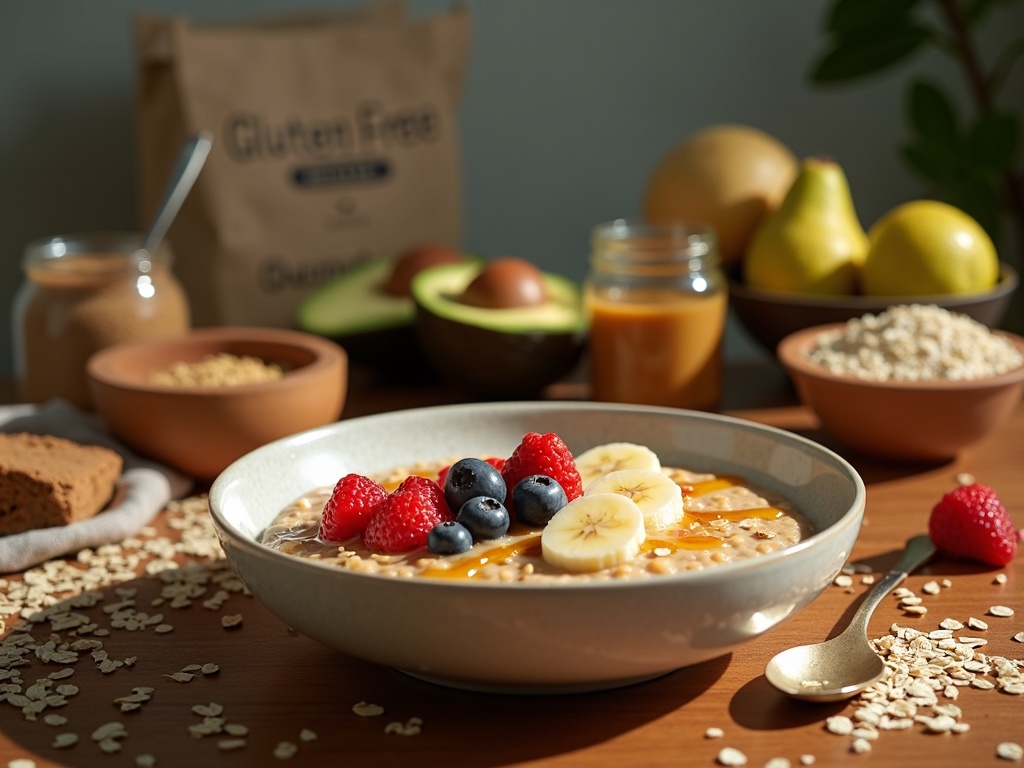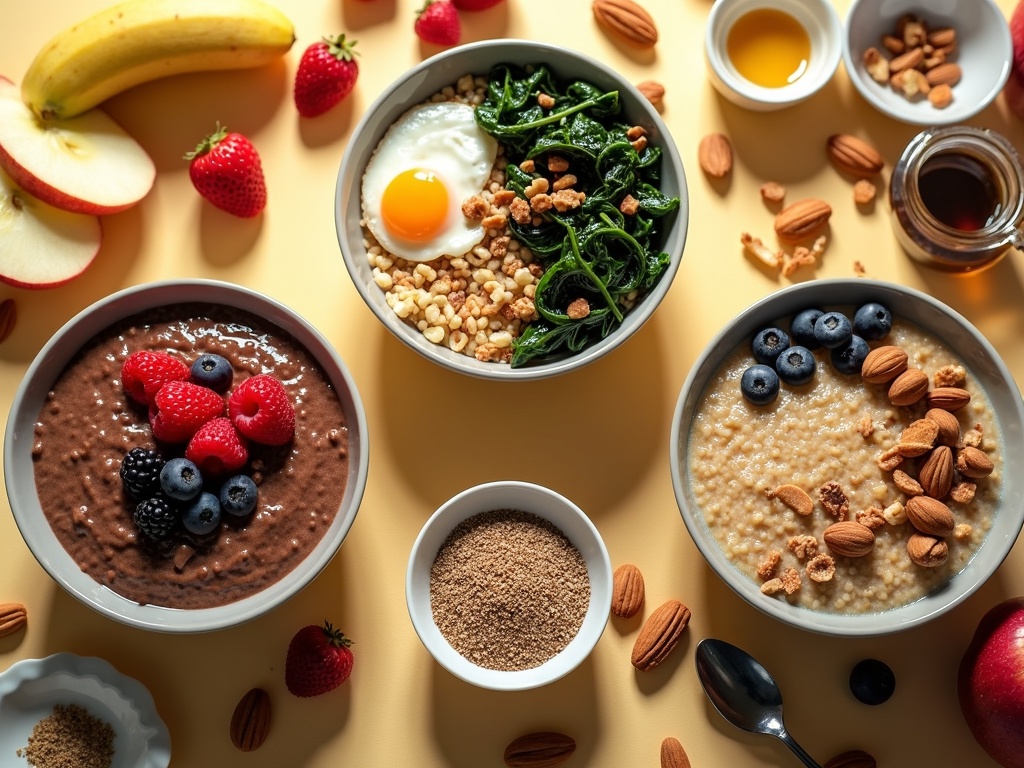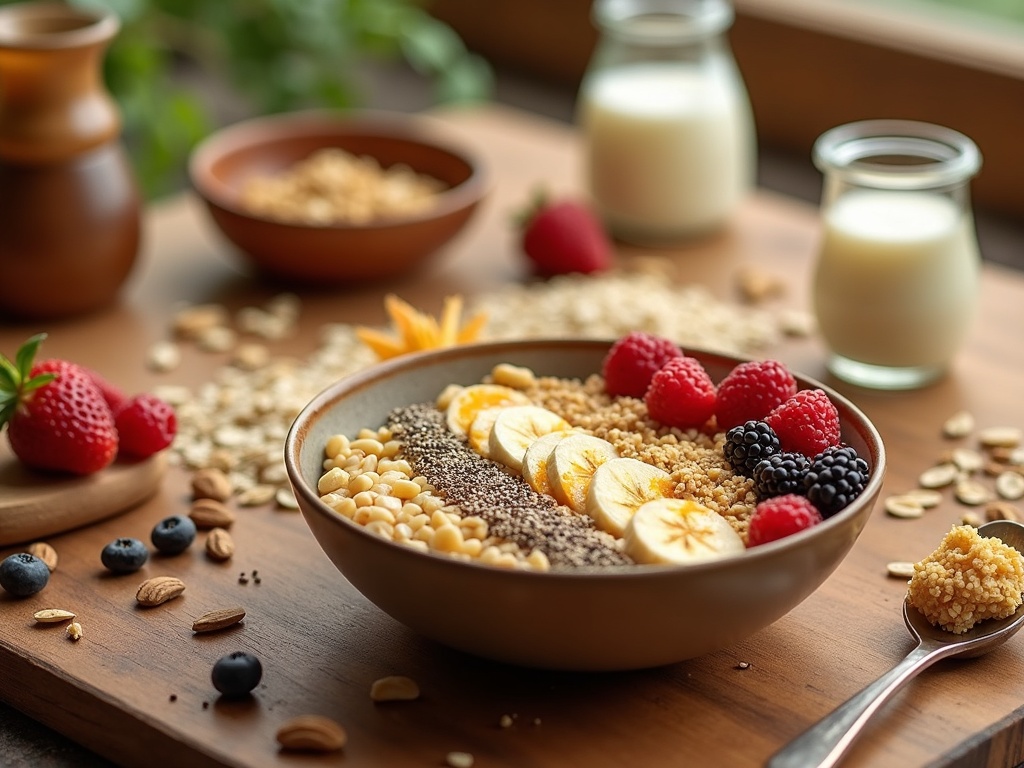Gluten free porridge has transformed from a niche product into a popular breakfast staple, with market projections reaching $43.49 billion by 2027. This nutritious option serves both people with medical conditions like celiac disease and non-celiac gluten sensitivity, and health-focused individuals looking for different grain options to start their day.
Find In This Article
Key Takeaways
- Naturally gluten-free grains like certified oats, quinoa, rice, millet, and buckwheat offer versatile porridge bases with unique nutritional profiles.
- For those with celiac disease (about 1% of the global population) and non-celiac gluten sensitivity, gluten-free porridge provides essential nutrition without triggering adverse health reactions.
- Gluten-free porridge offers impressive nutritional benefits including fiber, plant-based protein, and essential vitamins and minerals with approximately 150 calories per serving.
- The perfect gluten-free porridge requires proper techniques including rinsing the grains, appropriate cooking times, and seasoning to enhance flavor.
- Porridge can be customized with both sweet and savory variations, making it adaptable for different tastes while maintaining its nutritional benefits.
Why Gluten Free Porridge Matters
I’ve noticed a significant shift in breakfast preferences over the past few years. Gluten-free porridge has moved from specialty health stores to mainstream supermarket shelves, reflecting a growing market that’s projected to reach $43.49 billion by 2027. This isn’t just a passing trend – for many people, gluten-free options are a necessity.
Medical Necessity vs. Lifestyle Choice
For approximately 1% of the global population living with celiac disease, consuming gluten free foods isn’t optional – it’s essential for their health. When these individuals consume gluten (a protein found in wheat, barley, and rye), their immune system attacks their small intestine, causing long-term digestive issues and nutrient deficiencies.
Beyond those with celiac disease, many people experience non-celiac gluten sensitivity. These individuals don’t test positive for celiac disease but still experience uncomfortable symptoms like bloating, fatigue, and headaches after consuming gluten. For them, gluten-free breakfast options provide relief from these symptoms.
Gluten free porridge offers a safe, nutritious alternative that doesn’t trigger these adverse reactions while still providing the comfort and sustenance of a warm breakfast bowl.
Naturally Gluten Free Porridge Options
The beauty of gluten free porridge lies in its versatility. Several naturally gluten free grains make excellent porridge bases:
- Pure oats: Naturally gluten free, though often contaminated during processing (look for certified gluten-free oats)
- Quinoa: A complete protein that creates a nutty, creamy savory porridge alternative
- Rice: Perfect for congee-style porridges with a mild flavor
- Millet: Quick-cooking with a slightly sweet taste
- Buckwheat: Despite its name, it’s not related to wheat and makes hearty porridge
Each grain brings its unique flavor profile and nutritional benefits to your breakfast bowl. Quinoa offers complete protein, while millet provides essential minerals like magnesium and phosphorus.
I’ve found that combining different grains can create interesting textures and flavors. A mix of certified gluten-free oats with a touch of millet makes for a particularly satisfying bowl. Adding soaked dried fruits and nuts enhances both nutrition and taste.
Many people don’t realize that traditional porridge ingredients like wheat farina contain gluten. Switching to these naturally gluten free alternatives ensures those with celiac disease or gluten sensitivity can still enjoy a warm, comforting breakfast without health concerns.
The rise in healthy breakfast awareness has also contributed to the popularity of gluten-free porridge. Even those without dietary restrictions are discovering the benefits of diverse grains in their morning routine. Gluten-free porridges often contain more fiber and protein than their wheat-based counterparts.
For parents of children with celiac disease or gluten sensitivity, having nutritious breakfast options is particularly important. Gluten free porridge provides a familiar, comforting food that kids can enjoy without feeling different from their peers.
The increasing availability of gluten free products has made life easier for those requiring them. What was once difficult to find is now readily available, allowing more people to manage their dietary needs without sacrifice. This shift reflects growing awareness and understanding of conditions like celiac disease and gluten sensitivity.
Whether you’re switching to gluten free porridge out of necessity or curiosity, the options available today offer flavors and nutritional profiles to satisfy any breakfast preference.

Essential Ingredients and Health Benefits
Starting your day with a bowl of gluten free porridge isn’t just satisfying—it’s smart nutrition that keeps you energized for hours. I’ve found that the perfect gluten-free porridge begins with just a few simple ingredients, but delivers impressive health benefits.
Core Ingredients and Nutritional Profile
The foundation of any good gluten-free breakfast porridge starts with certified gluten-free oats. You’ll need 1 cup of either steel-cut or rolled oats—both work beautifully, though they create slightly different textures. Steel-cut oats offer a chewier bite, while rolled oats cook up creamier and faster.
Pair your oats with 2 cups of liquid—either water for a lighter porridge or plant-based milk for added creaminess and protein. I often use almond or oat milk for extra flavor depth. Don’t forget that small but crucial 1/2 teaspoon of salt, which balances the flavors and enhances the natural sweetness of your oats.
From a nutritional standpoint, gluten free porridge is a powerhouse breakfast option with approximately:
- 150 calories per serving
- 3g of healthy fats
- 6g of plant-based protein
- Abundant fiber (especially in steel-cut varieties)
- Essential B vitamins, iron, and magnesium
The beauty of healthy breakfast foods like porridge lies in their versatility. You can customize your bowl with various toppings: fresh fruits, nuts, seeds, honey, maple syrup, or even a sprinkle of cinnamon. Each addition brings its own nutritional benefits while keeping your breakfast interesting day after day.
I’ve noticed significant improvements in my digestive health since making gluten free porridge a morning staple. The high fiber content supports regular digestion and helps maintain steady blood sugar levels throughout the morning—no more mid-morning energy crashes!
For those interested in expanding their healthy breakfast options, porridge makes an excellent base for both sweet and savory variations. A simple shift from traditional sweet toppings to savory ingredients like avocado, eggs, or spinach transforms your morning savory oatmeal into something entirely new.
When selecting your oats, always look for certified gluten-free products to ensure they haven’t been cross-contaminated during processing. Some people with celiac disease or gluten sensitivity react even to trace amounts of gluten.
The whole grain nature of oats provides slow-releasing energy that keeps you feeling full longer than many other breakfast options. This makes gluten free porridge perfect for busy mornings when you need sustained energy.
For a make-ahead option similar to porridge, try preparing Bircher muesli with gluten-free oats soaked overnight in juice or milk—it offers the same nutritional benefits with no morning cooking required.
Whether you’re avoiding gluten for medical reasons or simply seeking more nutritious morning meals, gluten free porridge delivers exceptional nutrition in a comforting bowl. The combination of protein, fiber, and essential nutrients creates a breakfast that satisfies both taste buds and nutritional needs.
Creating the Perfect Bowl
Making gluten-free porridge isn’t just about throwing some oats in a pot. The perfect bowl starts with the right preparation and attention to detail. I’ve found that following a few key steps makes all the difference between a mediocre breakfast and one that’ll keep you coming back day after day.
The Essential Cooking Process
I always begin by rinsing my certified gluten free oats under cold water. This simple step removes excess starch and impurities, resulting in a cleaner-tasting porridge. Once rinsed, I set the oats aside and bring my cooking liquid to a boil in a medium saucepan. Water works perfectly fine, but for added creaminess, I often use plant-based milk or a combination of both.
When the liquid reaches a rolling boil, I add the oats along with a pinch of salt—yes, salt! This might seem counterintuitive for a sweet breakfast, but it actually enhances the natural flavors. The cooking time varies depending on the type of oats:
- Rolled oats: 10-15 minutes
- Steel-cut oats: 20-30 minutes
During cooking, I stir occasionally to prevent sticking and burning. The key is to keep an eye on the consistency—some people prefer a thicker porridge, while others like it more fluid. I can always add a splash more liquid if it becomes too thick.
Customization and Storage Options
Once my breakfast porridge reaches the desired consistency, it’s time for the fun part—adding sweeteners and toppings. I find maple syrup or honey adds just the right amount of sweetness, while fresh fruits provide natural sugars and brightness. For a vegan alternative, agave nectar works beautifully.
The beauty of healthy breakfast options like porridge is their versatility. I can make mine different every day with toppings like:
- Fresh berries, sliced bananas, or diced apples
- Chopped nuts for added protein and crunch
- Seeds like chia, flax, or pumpkin for omega-3s
- Coconut flakes or a dollop of nut butter for richness
- Warming spices like cinnamon, nutmeg, or cardamom
Porridge isn’t just for immediate consumption—it’s also perfect for meal prep. I often make a large batch on Sunday and portion it into containers for the week. When stored properly in an airtight container, healthy breakfast foods like porridge keep well in the refrigerator for 3-5 days.
For reheating, I add a splash of liquid and warm it on the stovetop or in the microwave. The texture might thicken overnight, but that’s easily fixed with a bit more milk or water.
For those days when I want something different yet still nutritious, I switch between Bircher muesli recipes and savory oatmeal options. This variety keeps my morning routine interesting while still maintaining the health benefits of gluten-free grains.
What makes this approach to porridge special is how it can be tailored to anyone’s dietary needs. For those avoiding dairy, plant-based milks create an equally creamy texture. If you’re watching your sugar intake, focus on fruit and spices rather than added sweeteners. The possibilities are endless, making gluten free porridge not just a meal, but a canvas for creativity each morning.
Common Mistakes and How to Avoid Them
Making gluten-free porridge might seem straightforward, but there are several pitfalls that can turn your breakfast from delightful to disappointing. I’ve encountered these mistakes firsthand and can help you navigate around them.
Top Porridge Pitfalls to Avoid
The most critical error many people make is using non-certified gluten free oats. Regular oats are often processed in facilities that handle wheat and can contain traces of gluten through cross-contamination. Always check packaging for clear “certified gluten-free” labeling to ensure your breakfast stays truly gluten-free.
Overcooking your porridge transforms what should be a creamy, satisfying texture into an unappetizing mushy mess. I find that maintaining a low-medium heat and stirring regularly produces the best consistency. Different types of gluten-free grains have varying cooking times, so watch your pot carefully rather than setting a timer and walking away.
Many cooks skip rinsing their grains before cooking, missing a crucial step. A quick rinse removes excess starch and any residual processing dust, resulting in a cleaner taste and improved texture in your final porridge dish.
Forgetting to season is another common oversight. Plain porridge can be bland, but simple additions transform it completely. Try these seasoning ideas for a more exciting bowl:
- Cinnamon and a touch of maple syrup for natural sweetness
- Fresh berries and a sprinkle of coconut flakes
- Sliced banana and a dollop of almond butter
- Savory versions with avocado, egg, and herbs
I’ve noticed many people reach for refined grain options when shopping for healthy breakfast alternatives. However, choosing whole grain varieties of millet, buckwheat, or quinoa provides more fiber, nutrients, and staying power than their refined counterparts. These intact grains create a hearty breakfast that keeps you satisfied until lunch.
The foundation of a great gluten-free breakfast is understanding these common mistakes. By avoiding these pitfalls, you’ll create a delicious porridge that supports your dietary needs while still delivering on taste and texture. With just a few adjustments to your cooking routine, you’ll transform your morning meal from merely acceptable to absolutely delightful.

Delicious Variations to Try
I’ve experimented with countless gluten free porridge recipes over the years, and these variations have become my absolute favorites. Each offers something unique while maintaining that comforting porridge experience we all crave for breakfast.
Sweet and Savory Options
Chocolate Porridge transforms an ordinary morning into something special. I combine certified gluten-free oats with unsweetened cocoa powder, a touch of maple syrup, and your choice of plant-based or regular milk. After cooking until creamy, I top it with fresh berries for a tantalizing contrast between rich chocolate and bright fruit flavors. This feels indulgent but remains nutritionally sound.
For those who prefer savory breakfasts, savory gluten-free porridge makes a wonderful alternative. I prepare the base with vegetable broth instead of milk, then add sautéed spinach, mushrooms, and top with a perfectly poached egg. The runny yolk creates a natural sauce that elevates the entire dish. This protein-packed option keeps me full for hours and makes a fantastic brunch choice.
Speaking of protein, quinoa porridge stands out as an exceptional alternative to traditional oats. Quinoa naturally contains more protein than most grains and adds a subtle nutty flavor. I rinse quinoa thoroughly, then cook it in milk until it develops that creamy porridge consistency. The texture remains slightly more nuanced than oat porridge, with each quinoa grain maintaining a gentle bite.
For busy mornings, overnight porridge options save precious time. I simply combine gluten free oats with milk and a tablespoon of chia seeds in a jar, refrigerate overnight, and wake up to ready-to-eat breakfast. This cold porridge variation works perfectly during warmer months when hot breakfast feels too heavy.
Customizing Your Bowl
The beauty of gluten free porridge lies in its adaptability through various toppings and mix-ins. Here are some outstanding combinations to consider:
- Fresh fruits: Berries, sliced banana, diced apple, or pear add natural sweetness and vital nutrients
- Nuts and seeds: Toasted almonds, walnuts, pumpkin seeds, or sunflower seeds contribute healthy fats and satisfying crunch
- Natural sweeteners: A drizzle of honey, maple syrup, or date syrup enhances flavor without refined sugar
- Spices: Cinnamon, nutmeg, cardamom, or vanilla extract transform the flavor profile entirely
- Protein boosters: Stir in a spoonful of almond butter, tahini, or plant-based protein powder
I find that having a rotation of these toppings prevents breakfast boredom while ensuring I get varied nutrition throughout the week. For instance, Monday might feature a cinnamon-apple combination, while Wednesday brings chocolate-banana, and Friday introduces a savory spinach-egg variation.
For those new to gluten-free breakfasts, remember that cross-contamination remains a concern. Even naturally gluten free grains like quinoa can be processed in facilities handling wheat. I always recommend purchasing certified gluten-free ingredients, especially if preparing for someone with celiac disease or severe gluten sensitivity.
The versatility of gluten free porridge makes it an ideal foundation for healthy breakfast options that satisfy diverse dietary needs. Whether you’re cooking for yourself or your family, these variations ensure that breakfast remains the exciting, nourishing meal it should be.
Don’t hesitate to mix and match these ideas based on what’s available in your pantry. Some of my most delightful porridge discoveries happened when I improvised with whatever ingredients I had on hand. This flexibility makes gluten-free porridge a reliable healthy breakfast food for everyday enjoyment.

Sources:
ResearchAndMarkets.com – Gluten-Free Foods Market 2021-2027
Healthline – Health Benefits of Oats
Celiac.org – Understanding Gluten: Myths and Facts

